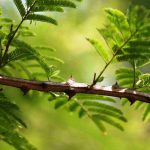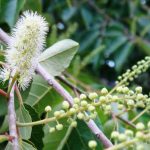TREE LIFE
JUNE 1988
HARARE CALENDAR
Tuesday 4th June 1988: Botanic Garden Walk. Meet in the car park at 10.45 for 11.00 am. We’ll either complete the examination of the Zambezi COMBRETACEAE started in April or perhaps continue with the Rain forest outliers which we looke at in May.
Sunday 19th June: A.G.M. and Lake Macllwaine outing.
The 38th Annual General Meeting of the Tree Society of Zimbabwe will take place at the Harare Sports Yacht Club, Lake Macllwaine, on Sunday 19th June at 10.00 mm.
A.G.M. AGENDA
- Notice convening the meeting
- Minutes of the last A.G.M.
- Matters arising
- Chairman’s Report
- Treasurer’s Report
- Election of Officers
- Any other-business
Any proposals/resolutions and nominations for office-bearers should be forwarded to Box 2128, Harare by 1st June 1988, if possible, although proposals and nominations will be accepted from the floor.
We propose having tea in advance of the meeting at 9.30 and the club is, in fact, laying it on at 5c per head. There are fine lawns with tables and chairs and a large verandah. After the meeting we’ll look around the vegetation around the club. For lunch there are good braai facilities at the club so bring a braai pack or your picnic lunch as usual. (Speak to Vida Siebert about $2,50 braai packs!)
After lunch we hope to be able to walk through the bird sanctuary. NB No bus- Use own transport.
Saturday 25th June : Mukuvisi Woodlands Meeting. Meet at 3.00p.m. at Paget Road/Nyanga Crescent gate.
Saturday 2nd July : Botanic Gardens Walk at 10.45 a.m.
Saturday and Sundy 2nd and 3rd July : A small party is going to “recce” the Hippo Pools camp at Umfurudzi Safari Area north of Shamva. Contact Chairman if you are especially interested.
MATABELELAND CALENDAR
On Sunday, June l2th, we will go, together with the Aloe and Cactus Society, to Falcon College, Esigodini, to their Quiet Waters Area, and to do some Tree-naming. A good lunch at $3,50 will be available, unless it is preferred to bring one’s own. We will hope to see some of our Shangani and Gweru friends too. Meet at the Hotel Rio, at 8.30 a.m. (cars may be left there).
On Sunday, May 1st, we went to the Pasi Pasi Area, adjoining a region of Kalahari Sand. Primarily, we went to hear 4 Papers on Acacia species; Thora Hartley on A. erioloba, Barbara Goddard on A. rehmanniana, Albert Lehurey on A. karroo, and Charles Sykes on A. fleckii. The most interesting facts to emerge came from a discussion on Acacia erioloba, and the occasional poison-nature of its pods, usually such “excellent stock feed”. Further it appears that Kudu deaths have been reported, when they have been fenced in, and forced to over browse and over graze a limited area, as opposed to their normal habit of lightly browsing and lightly grazing, and then moving on. Apparently some trees at least, have a defensive mechanism. After being well-browsed, it seems that there is an increase in Tannic Acid in the leaves, rendering them unpalatable for a while, and thus giving them time to recover.
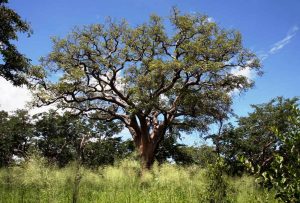
Ricinodendron rautanenii. Photo: Bart Wursten. Source: Flora of Zimbabwe
We also went into the Teak area, right on Kalahari Sand, where we saw the wide spread and varied Baikiaea plurijuga, and the Bushmans staple – several fine Ricinodendron rautanenii with some grounded fruits. It was interesting to note the Acacia varieties, just before we entered the Kalahari Sand. Acacia fleckii was particularly widespread, not quite dominant, and not yet thicketing, although we do see thickets along side parts of the Umgusa Dam, near Bulawayo.
Altogether a useful, pleasant and instructive morning.
-C. SYKES
RECEIPTS
The Treasurer has asked me to say that it has not been possible to send out receipts for moneys received. This is not because the money has been pocketed, but because receipt books have been in short supply. Normal service will re-sume a.s.a.p
OUTING TO HENRY HALLAM DAM : 17TH APRIL 1988 (Morning Walk)
Approximately 35 members and friends gathered at the picnic site below the dam wall of Henry Hallam Dam. After a short walk as a group, the party split into two, one group following Kim and the other group going with Meg and Phil back along the road away from the dam wall. The walk took us through very sandy woodland more or less parallel to the Manyame River.
Throughout the walk the family RUBIACEAE were much in evidence, although most species were in leaf with no flowers or fruit. Some of the characteristics of the family – opposite (sometimes whorled) leaves, the presence of interpetiolar stipules and the inferior ovary – were illustrated by the species seen. Kim showed us Canthium lactescens, squeezing out some milk from the terminal bud to demonstrate its specific name. Later, small bushes of Psydrax livida (formerly Canthium huillense) were found with their ovate leaves and green branchlets. Occurring reasonably close together were examples of the related genera Vangueria and Vangueriopsis. Meg showed how Vangueria infausta has dull leaves, which are furry on both sides and are susceptible to attack by a gall. Vangueriopsis lanciflora on the other hand had shiny leaves and branchlets which show orange when rubbed.
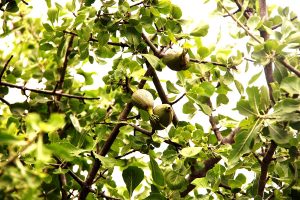
Gardenia volkensii. Photo: Petra Ballings. Source: Flora of Zimbabwe
A striking specimen of Gardenia volkensii, covered in fruit the size of small lemons was found. Other species from RUBIACEAE were Pavetta schumanniana and Tarenna neurophylla.
From the family VERBENACEAE we were shown two trees in fruit – Vitex payos and Clerodendrum glabrum. Meg pointed out the characteristic bark of the Vitex, its digitate leaf with 5 leaflets and the fruits which were still green at this stage and enclosed by the persistent calyx.
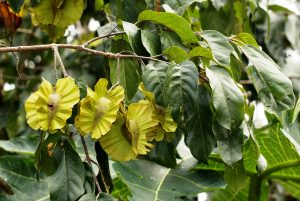
Combretum zeyheri. Photo: Bart Wursten. Source: Flora of Zimbabwe
We both saw and smelt Pittosporum viridiflorum, which was still partly in flower. A number of small trees of Parinari curatellifolia were found, enabling us to handle and examine the leaves. Four Combretum were seen, C. collinum, C. erythrophyllum, C. mollis and C. zeyheri.
The family with the largest number of species was probably the LEGUMINOSAE, with species from the three main sections of the family being well represented. We saw Acacia sieberiana, Albizia amara, A. antunesiana, Burkea africana, Cassia abbreviata, Peltophorum africanum, Pterocarpus angolensis, P. rotundifolius, Schotia brachypetala and Swartzia madagascariensis. Also we saw Brachystegia spiciformis trees, some of which had the enormous Musasa moth caterpillars on their trunks.
Plants other than trees were not neglected. The attractive white flowers of Plumbago zeylancia growing in shade by the roadside were identified by Meg. An enormous Asparagus was seen which had ascended about 4 meters into a Boscia tree. Patches of leaves of Leptactina benguellensis (RUBIACEAE again) were seen on the woodland floor.
-Mark Hyde
OUTING TO MUNI FARM : 15TH MAY 1988
The farm is in the Umboe Valley just west of Chinhoyi and is of interest, being situated in an unusual geological feature. In his geological report of the area, J.G.Stagman (1961) describes the area as being practically featureless, with a total relief of less than 200 feet in an area that exceeds 200 square miles. This flat country is composed of rocks of Arkose group, lying between bands of hiss forming dolomites, which are all rocks of the Lomagundi system. Stagman further suggests that in the recent geological past, the valley was a lake basin. The subsequent discovery of a high yielding aquifer on Muni Farm probably confirms this idea. The Mungwe river, cutting back through the hills to the N.W. eventually drained the lake, and removed most of the floor covering. However, areas of alluvium remain, reaching 200 feet in thickness on Fupi Farm, which borders Muni to the East. Elsewhere the valley is covered by a deep mantle of fine grained sandy soil with few rock outcrops.
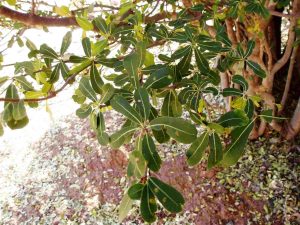
Manilkara mochisia. Photo: Mark Hyde. Source: Flora of Zimbabwe
The area we examined bordered between the alluvium and the fine grained sandy soils, the country rather resembling an extended vlei due, probably, to its flat nature, and consequent high water table. The presence of Colophospermum mopane would indicate a build up of salts in places. The tree cover on the alluvium was restricted to ant-heap islands in a sea of grassland, and one may speculate that the drier regime created by these fairly large termitaria favoured the occurrence of spectacular specimens of the SAPOTACEAE : Manilkara mochisia and Mimusops zeyheri. Crowded on these islands were the species usually found on ant-heaps, Lannea stuhlmannii and L. discolor, Diospyros lycioides and D. mespiliformis, Euclea divinorum, Cassia abbreviate, Ziziphus mucronata, Lonchorcarpus capassa, Ficus thonningii, Euphorbia ingens, Grewia flavescens and G. monticola, Pappea capensis, Azanza garckeana, Bauhinioa thonninngii and an under storey of Allophyllus africanus, Rhus longipes, Ehretia amoena, Ximenia americana, and a RUBIACEAE which was probably Feretia. On the fringes of these islands we found rather poorly grown Acacia gerrardii and A. goetzei, Cassia sinqueana, Combetum frangrens, Gardenia ternifolia, Diospyros kirkii, Vitex payos and Maytenus senegalensis. Further up the road, though hardly up in elevation, we came upon open woodland, which probably indicated a change from the alluvium to the deeper sands. With the presence of Parinari curatellifolia one would suspect a fairly high water table in a wet season, however the depth of soil supported fine specimens of Afzelia quanzensis, along with Brachystegia boehmii, Diplorhynchus condylocarpon, Pseudolachnostylis maprounefolia, Terminalia mollis and T. sericea, Crossopteryx febrifuga, Faurea speciosa, Burkea Africana, Kigelia Africana, Dombeya rotundifolia, Ochna schweinfurthiana. The previous season must have been conducive to fruiting, particularly in the Cassia abbreviata and Afzelia quanzensis and Antidesma venosum showed an attractive display of tassel berries. The return journey was interrupted to examine different species of Ficus, F. stuhlmanii, F. sur, F. sycamorus, F. thonningii and F. ingens.
A somewhat delayed lunch was taken on the strawberry lawn at the home of Fred and Maud Wolhuter, and we thank them for their kind hospitality. The tea and cakes on arrival were most welcome, as was the tea provided with lunch. We very much appreciated their knowledge of the local flora and fauna, gained through their long association with the Umboe Valley.
A final walk around the garden, crowned with gigantic Jacarandas, led across the barnyard to the most interesting botanical specimen of the day – the wooden pear. The tree was bearing fruit to prove its kind, but had simple leaves, since Schrebera alata has a compound leaf with a winged rachis and winged petiole, this one had to be Schrebera trichoclada. Identification without fruit should be easy, for on crushing a leaf there was an unmistabeable smell – stink bugs – and definitely no bugs to be seen.
-D.D.Hicks
HOLD MY HAND – I AM A STRANGER IN PAMPLEMOUSSES
Before I came to Mauritius I thought that a Pamplemousse was a large grapefruit from which members of the Women’s Institute make delicious marmalade. There is a connection, though. The village of this name is thought to have taken its name from a tree that was introduced from Java by the Dutch, Citrus maxima. Its common name is Pamplamoucier in French and Bambolmas in Tamil. The gardens are called the Royal Botanic Gardens, Pamplemousses, and enjoy an international reputation containing about 500 species of plants including 80 species of palms.
Most of the species are exotic to Mauritius and have been gathered from the four corners of the tropical and sub tropical world. There are only 25 species indigenous to the Mascarene Islands (that is, the islands of Mauritius and Reunion) of which ten are palms. The early settlers, especially the Dutch, denuded the coastal areas of many indigenous trees and island of most of the indigenous wildlife including the dodo.
A trip around the Gardens is a trip into a new arboreal scene. Not completely, though, near the gate house stands a known tree – Adansonia digitata (baobab) and else where we found Holarrhana pubescens, Albizia amara, Combretum microphyllum – old friends in a strange world. There are a number of figs, but most are exotic Ficus religiosa (The Pipal tree), F. bengalensis (The banyan), F. alastica. There are palm trees shaped like bottles, Hyphoebe laqeni, caulis palms on stilt roots, Verachaffeltia spendida, palm trees that take up to 60 years to mature, produce a towering spray of 50 million flowers that overtop the tree by up to 6 meters and then die – Cordyla umbraculifora (Talipot palm). Palms that produce coconuts, palms that produce dates, palms that are topped for sugar, others that are topped for Toddy, some that are steamed and eaten, some that produce more oil per hectare than any other oil yielding crop, some for making rattan furniture. They are all there.
Firstly the French, and then the British administrators seemed to have secured their empires to populate the gardens with useful and ornamental trees. Albizia lebbeck was introduced because the charcoal could be used in the production of gunpowder, Cinnamonum zeylanicum, used as a condiment, Myristica fragrens (netmeg), Pimenta acris (Bay Rum Tree – allspice, Clove, Sandalwood, Tactona grandis (Teak) from India, Diptero carpus elatus (same family as Meranti) from Malylaysia, Araucaria columnaris (Norfolk Island Pine) from Polynesia, Andira surinamensis (Bastard Mahogany) from South America, Agathis robusta afrom Australia, Seripa americana from the West Indies ….
But surely, this is where I came in. Welcome to Pamplemousses.
BOTANIC GARDEN WALK – 7TH MAY, 1988
This month we had the pleasure of being shown a selection of inhabitants of the rain forest outliers and that is areas of higher moisture in otherwise relatively dry zones away from the main rain forest. Often these areas are kopjes, anthills, riverine swampy etc. Some of the trees were familiar to us in Harare, but some are absolute rarities. We were shown the well known Cordia abyssinica, Calodendrum capense and Dais cotinifolia all of which are popular garden subjects due to their spectacular flowers. Zanha qolungensis is one which we have seen as close as Shamva.
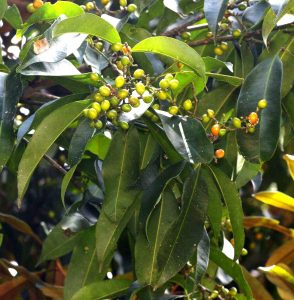
Teclea nobilis. Photo: Bart Wursten. Source: Flora of Zimbabwe
Teclea nobilis was one of the rarities, while Allophylus rubrifolius occurs at Murawa hill, Mutare. Terminalia quanzensis is the outlier Terminalia. A classic forest outlier is Homalium dentatum which we got to know so well at Matopos.
A rarity was Stadmania oppositifolia from Nyeri Hills in the lowveld. Another was the “other” bamboo Oreobambos buchwaldii which only occurs on Buchwa mountain. A quirk in the botanical order of things is Cassipourea euryoides also seen at Nyone Hills. This has opposite leaves with inter-petiolar stipules which ordinarily would put it in RUBIACEAE. However, it is not in that family. The clue is the serrated leaves and it is from another small family, the RHIZOPHORACEAE.
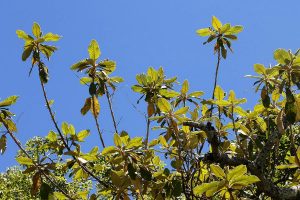
Tarchonanthus trilobus. Photo: Bart Wursten. Source: Flora of Zimbabwe
More rarities, Dalgergia boehmii, Fagaropsis angolensis, Tarchonanthus trilobus and a couple of little less so, Euclea schimperi and Osyris lanceolata. What I did not know before about the latter is that it can be a root parasite of msasa – Brachystegia spiciformis.
Perhaps the rarest tree in Zimbabwe is Juniperus procera from a hill near van Niekerk ruins. Only one tree is known in the wild with the nearest of its kind occurring in Malawi. The second Zimbabwe specimen is the one growing in the Gardens from fruit collected from the original specimen by the late Professor Wild.
Thanks to Tom, another most rewarding morning.
USING TREES TO FERTILIZE SOIL
Trees can be an important source of fertilizer that does not require spending hard earned cash once they are planted. Furthermore, they have many other positive effects on the environment, including reducing soil erosion, acting as windbreaks and shading crops as well as providing sources of forage food and pharmaceutical products. Above all, trees are also relied on for producing valuable sources of fuel wood , mainly the form of twigs and branches, and even lumber when they mature and can be replaced by other trees. It is the nitrogen fixing ability of leguminous trees that makes them of special value for improving soil fertility. This is especially the case for trees such as Acacia, Albizia and Prosopis. Several genera of Papilioneae have also been found to be capable of forming rhizobianodules, including Dalbergia, Erythrina and Sesbania.
Litter falling from trees enriches the soil with large quantities of nitrogen and minerals absorbed by the trees, often from considerable depths. Studies carried out in Hawaii showed that leucaena leaves contained phosphorus and potassium, as well as calcium and numerous trace elements. An added bonus is the increase of organic matter content of the soil that unlike chemical fertilizers, represents a much more lasting contribution to future crop production.
DICK HICKS CHAIRMAN


